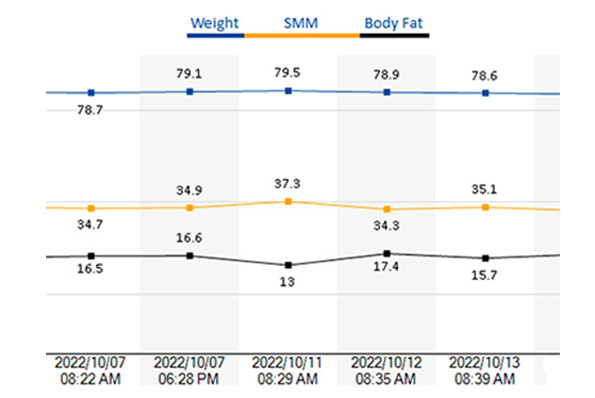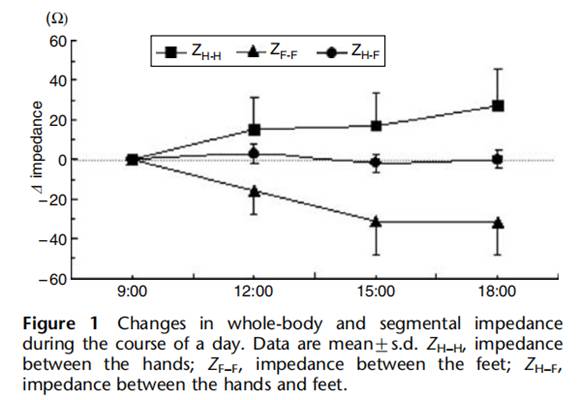Why aren't measurement results identical?

I've purchased a body composition analyzer for use at home or in my office, and I measure several times a day to try it out, and discover that each result is slightly different. Is there something wrong with my device? Shouldn't results be identical? After all, my body can't have actually in weight or body fat in the past half hour, right?
Flagship vs economy models, or "you get what you pay for"
Obviously, the goal of any measurement device is to strive for "100% accuracy, 100% repeatability". However, like any other product, there are different levels of performance when it comes to measurement devices. The newest flagship smartphone will offer better performance than a cheaper model from a few years ago! Similarly, basic bathroom scales can be found relatively cheaply at your local big box store, and yet there are "professional" variants of consumer devices that can retail for hundreds of dollars each.
The "accuracy level" of a scale can be defined in different ways, such as by Metrology standards used in Europe to certify weight measurement. If you have a scale that claims an accuracy level of ±1%, that means if someone weighing 100 kg uses it, while the goal is for it to measure and display 100 kg, we can reasonably expect the results to fall within 99-101 kg. (if the range is ±2%, then expected results would be within 98-102 kg).
Similarly, for someone whose "true" weight is 65.30 kg, suppose they measure 3 times consecutively, receiving results of 65.30 kg, 65.05 kg, and 65.55 kg. The lowest 65.05 and highest 65.30 are both 0.25 kg "off" compared to the person's actual weight, demonstrating an accuracy level of roughly ±0.4%.
Is this performance good enough? That depends greatly on where the scale is used!
If used in a hospital, where weight measurement results may be used to calculate medication such as the amount of anesthetic, you would most likely need a medically certified scale with higher accuracy/stability/reliability standards (especially when it comes to infants, where even a relatively small error can result in disastrous outcomes!). If you're using it at home to track changes for yourself and your family, then an accuracy level of ±1% may be more than enough for your needs.
What can I do to improve the accuracy of my results?
While it's true that "you get what you pay for", is there anything I can do to improve the consistency and accuracy of results from the device I use at home?
Of course! For example, placing a scale upon carpet will make it harder to receive accurate measurements, compared to placing it on a solid, hard floor.
In short, by taking a little bit of extra care to follow recommended procedure before measurement, you can increase the accuracy of your results!
Is variation normal for body composition results as well?
Body Composition Analyzers using Bioelectrical Impedance Analysis technology are a bit more complex compared to Weight Scales. In addition to Weight, they may also utilize information such as Height, Gender, Age, Bioelectrical Impedance, and more variables to calculate results. As noted above, precision is a factor that comes into play for any measurement, and impedance is no exception! Typically, a normal target for BIA devices is about ±1~2% for impedance. But even if the impedance measured by a device is 100% accurate, your body composition results may display some variation even within the same day. Why is that?

Source:Y Oshima, T Shiga. Within-day variability of whole-body and segmental bioelectrical impedance in a standing position. European journal of clinical nutrition (2006) 60, 938-941).
Research indicates that bioelectrical impedance changes throughout the course of a day (due to activity, posture, and other factors), especially in the legs and arms. The difference is smaller for whole-body measurement, but there is still a certain level of variation, and it's not natural for impedance (and thus results) to be identical. If a device provides body fat results of 18.6%, 18.9%, and 19.2% for a person, the biggest difference is 0.6%, which is quite small - this would be a sign of good consistency and reproducibility!
How to minimize the effect of "temporary" changes in impedance, and reflect primarily "true" changes in impedance caused by actual changes in body composition, is a key aspect of Bioelectrical Impedance Analysis research.
Is it always a good sign if results are nearly identical?
If I buy a cheap body composition analyzer, and the body fat results are almost identical every single time, does that mean I got a great "professional-grade" device?
While it's not impossible, this is unlikely to be the case. It's true that professional medical-grade body composition analyzers can provide more accuracy and better consistency than a consumer-grade device. However, if you were able to buy the device cheaply online, it's a possibility that this product primarily uses weight/height as variables for calculating results, and bioelectrical impedance is only a tiny factor in the algorithm. In this case, so long as weight is consistent, all the other results will be consistent as well! (because a certain level of variation is normal for impedance) That means the device would be limited in its ability to detect and reflect true change in body composition (or it would be much less sensitive). There's nothing wrong with purchasing a device that fits your budget, of course, but be aware of its limitations!
What can I do to improve accuracy of body composition results?
Although variation in impedance is natural, as users there are still things you can do to improve accuracy of results, by taking into account the science of how BIA works! This is why all BIA devices will advise you to:
1) Do not measure directly after exercise
2) Do not measure directly after eating/drinking
3) Measure in room temperature
4) Remove shoes/socks before measurement
5) Input accurate height
6) Measure at the same time each day (ideally morning to reduce variables caused by daily activity)
Body Composition Analyzers are a convenient tool that allow us to assess our bodies safely and quickly! Although there will be inherent differences in accuracy and consistency between professional and consumer-grade devices, by following the recommended pre-measurement procedure, you can improve the accuracy of your results!